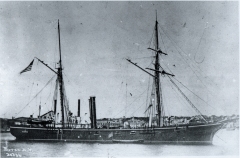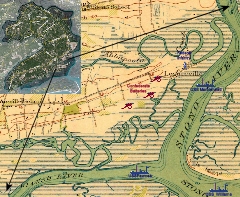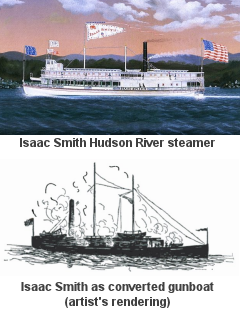2013 and 2014 mark the 150th anniversary of important Civil War engagements on Johns Island. This series of posts describes these actions. The second in the series, this article relates two land / sea actions, one successful, one not, where Rebel artillery attempted to capture Federal gunboats.
Blockade – Patrolling the Stono.
With the victory at Port Royal and capture of Hilton Head and St Helena’s Islands in November 1861, the Federal Navy was in an excellent position to enforce the blockade of Charleston Harbor. All through 1862 Union ships patrolled off the harbor and up the Edisto and Stono Rivers while major battles such as Shiloh, Antietam and Fredericksburg were being fought elsewhere.
One of the Port Royal ships was the USS Isaac Smith (450 tons displacement, 171 feet long). Built in 1851 as a Hudson River steamer she was pressed into service in September 1861 and refitted as a gunboat with a 30 pound Parrot rifle and eight 8†cannons. After Port Royal, she patrolled the inland waters around Savannah, St Augustine and Jacksonville. In October 1862 she was assigned to patrol the Stono River along with the USS McDonough, an impressed former ferryboat.
A Great Victory!
Confederate forces found these patrols very annoying. They prevented easy movement along the inland waterways and threatened their forces on James Island. Confederate Generals Roswell Ripley and P.G.T. Beauregard, both experienced and successful officers, devised a plan to stop these patrols. They assigned Lt. Col. Joseph Yates of the 1st SC Artillery to secretly install batteries along the Stono River on Johns and James Islands, two batteries on each for a total of about twelve guns. On Johns Island the cannon were placed at the Grimbal Plantation, where the Executive Airport is currently located, and downstream near Legareville.
On the afternoon of January 30, 1863, the Smith made its way upriver on a regular patrol and anchored almost 5 miles from the Stono Inlet, directly opposite the two northernmost hidden batteries. The Confederate artilleryman took quick advantage of their well-planned opportunity and opened an intense barrage. The Union commander, Acting Lt. Francis Conover, cut his anchor line and the crew began to return an equally hot fire. As they began to get underway, a Confederate shell destroyed their smokestack, disabling the engine. At about the same time the Smith also began to come under fire from the opposite shore as they headed downstream. Unable to maneuver and with 8 men dead and 17 wounded, Lt. Conover surrendered. The USS McDonough attempted to steam up the river to rescue the Smith but was driven off.
The Smith and the Union prisoners were brought into Charleston amid great celebration. One of the Smith’s crew, Richard Stout, who lost his arm in the battle, was awarded the Congressional Medal of Honor; “with crippled arm stayed at his post and fought until the Smith surrenderedâ€. The ship was renamed the CSS Stono and served in Charleston until June 1863 when she was wrecked while being pursued by the Union Navy trying to run the blockade.

USS Marblehead – click to enlarge
A Second Attempt.
Having succeeded once, the Confederates decided to try again. Federal forces had been regularly landing at Legareville on Johns Island and occupying the village at the junction of the Stono and Abbapoola Creek. They were taking wood from the houses in the village to use at their encampment on Folly Beach. This was an additional annoyance to the Confederates and one they wanted to stop.
In mid-December, 1863, General Beauregard again ordered artillery to be quietly maneuvered into place under the cover of darkness, this time a little further south. Union ships had been hesitant about going further up the Stono since the capture of the Smith. These batteries were under the command of Lt. Col. Delaware Kemper and were assisted by the local Johns Island unit, the Stono Scouts. Three batteries were placed on Johns Island each having four guns. One was placed above Legareville to cover the village. The other two were at the junction of the Stono and Kiawah Rivers. This time, General Beauregard did not move any cannon to the James Island side of the Stono.
The USS Marblehead, a purpose built Federal gunboat somewhat larger than the Smith was regularly patrolling the Stono along with the USS Pawnee. The Marblehead had landed troops at Legareville on December 19th and was still there on Christmas Eve, 1863. That night the Confederates completed their preparations.

Map – Click to enlarge
Heroism on the Marblehead.
At sunrise on Christmas morning 1863, the Marblehead lay 300 yards off shore from Legareville. At 6:10 the batteries opened fire. The Federal ship again slipped its anchor, and with one of two boilers disabled began to move downstream. But this time things went differently. With no fire coming from the opposite shore on James Island, the Marblehead stopped near the lower batteries and began returning fire. At the same time the USS Pawnee began to move around from the Kiawah River and took the batteries under fire. The USS C.P. Williams further down river also began to move up to assist.
After an hour of intense fighting, Confederate Col. Kemper could not see any effect on the Marblehead and he ordered his forces to withdraw. In fact the Marblehead had been hit more than twenty times. The fire had been so intense that four of the Marblehead’s sailors were eventually awarded the Congressional Medal of Honor. One, Quartermaster James Miller, remained in an exposed position throughout the battle to take soundings saving the Marblehead from running aground. Another, Robert Blake, was a steward aboard the Marblehead and had no assigned combat duties and could have by rights stayed below during the action. Instead, he readily assumed the duties of a wounded powder boy helping that gun stay in action. The first African-American recipient of the Medal of Honor, he had been born a slave on a plantation in Santee, SC.
Despite the Confederate Commander’s judgment that their fire had been ineffectual, the Marblehead was so badly damaged it had to return to New York for repairs and saw no further action in the war. In a final postscript, the crew of Pawnee returned three days later and recovered two howitzers that had been abandoned by the Confederates in the marsh. These howitzers are on display to this day in the Washington Navel Yard.
Next: February 1864, The Battle of Haulover Creek

 War Comes
War Comes

I’d like to have permission to reprint some of this historical material about Johns Island in the Seabrooker newspaper of which I am the editor. I think it would help get your group and this website in front of our 4,000 Johns Island readers. Who should I contact about this?
Fascinating stuff! The tactics of controlling a river would seem rather daunting with hidden artillery on the shores. Keep the articles coming.